airbag VOLKSWAGEN GOLF PLUS 2012 Owners Manual
[x] Cancel search | Manufacturer: VOLKSWAGEN, Model Year: 2012, Model line: GOLF PLUS, Model: VOLKSWAGEN GOLF PLUS 2012Pages: 541, PDF Size: 98.86 MB
Page 10 of 541
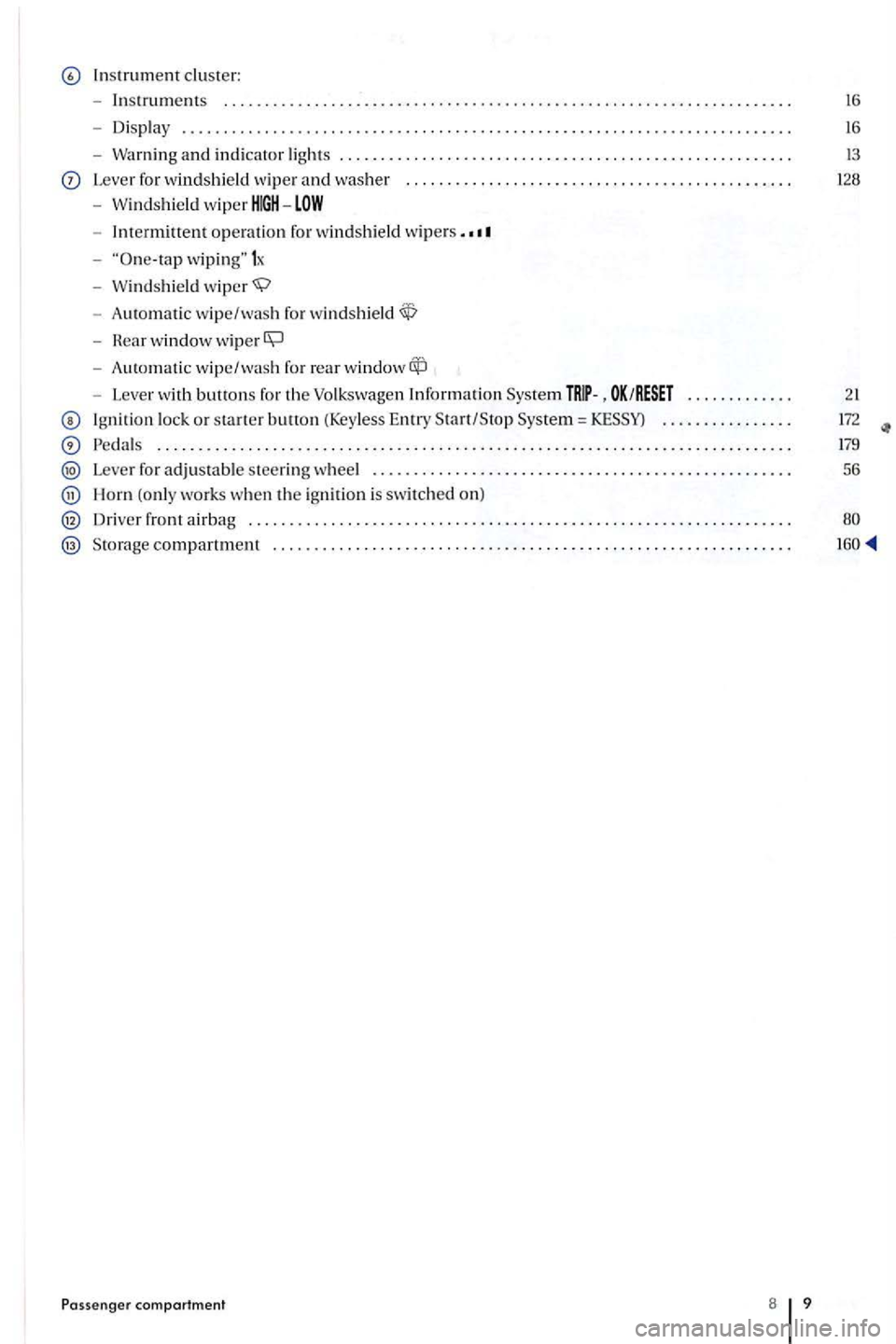
Instrument cluster:
- Instr
uments .................................. o o o............ 16
- Disp lay ............................ o o 16
-Warning and in dicator lig hts ............... ..... o o o ... 13
Lever for windshi eld wip er and washer ........ o o
-Imermittent o pe rat ion for windshi eld wip ers .
-wiping" 1x
- W
indshield
- Rear window wip er
- Aut om ati c wipe/wash rea r
-Lever with buttons for the Volkswagen Information
Ignit ion lock or starter butto n (Keyless Ent ry .............
..... ........................................................ .......
Lever for adjustable s teering wheel ........................... o o
Horn (o nl y work s w hen the ign ition is sw itched o n)
Driver front airbag ............................... ........... o o o
o o
Pa ssenger compartment 8 9
172
179
56
Page 13 of 541
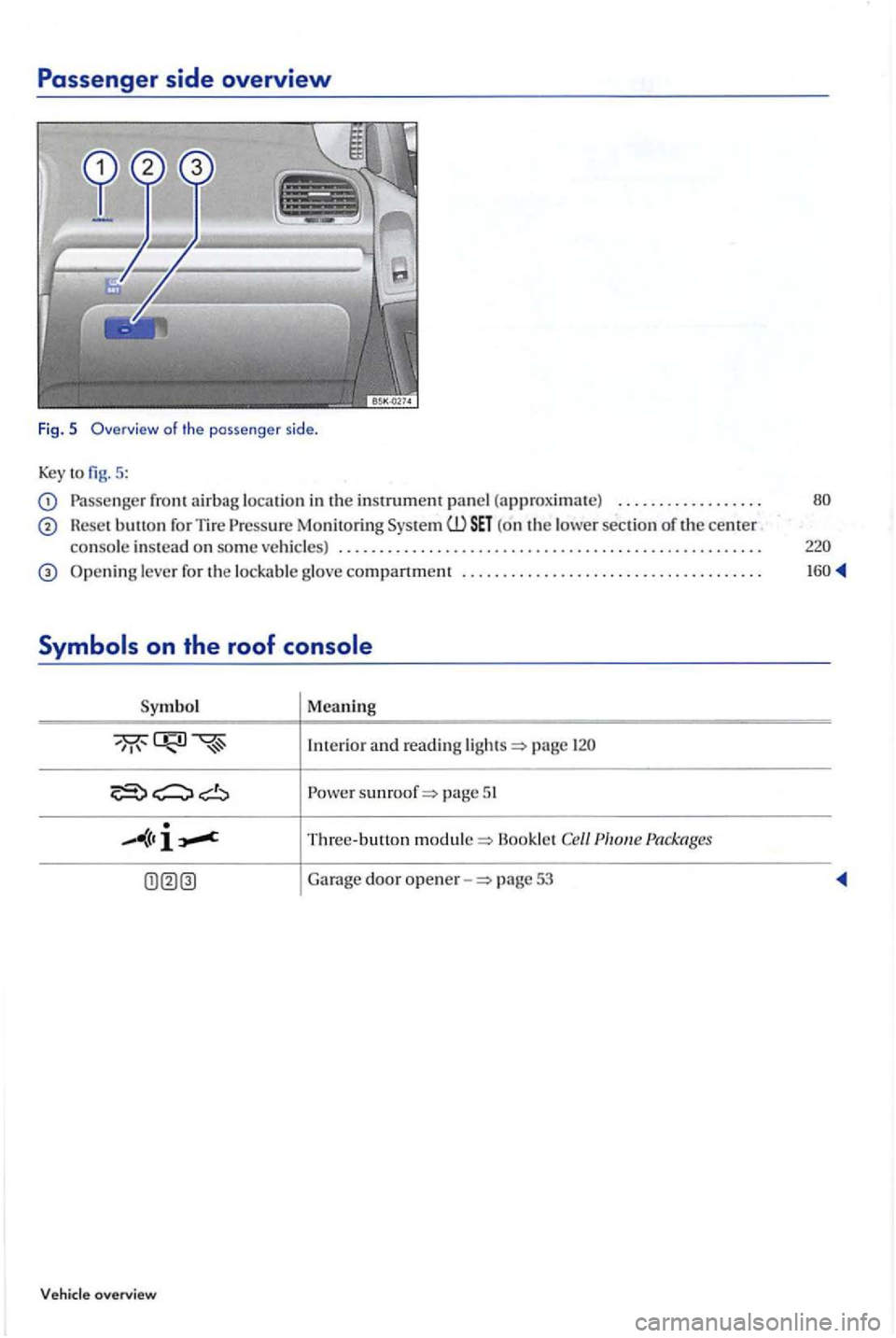
Passenger side overview
Fig. 5
5:
Passe nger front airbag location in the instrument pa ne l (approx imate) . . . . . . . . . . . . . . . . . .
Reset bullo n for Tire (o n th e lower section of Lhe center co nsole in stead on so me ve hicl es) . . . . . . . . . . . . . . . . . . . . . . . . . . . . . . . . . . . . . . . . . . . . . . . . . . . .
Symbol Meaning
Interior and reading p age
sunroof=> page 5 1
Three-buuon module=> B ook le t
53
overview
Page 40 of 541
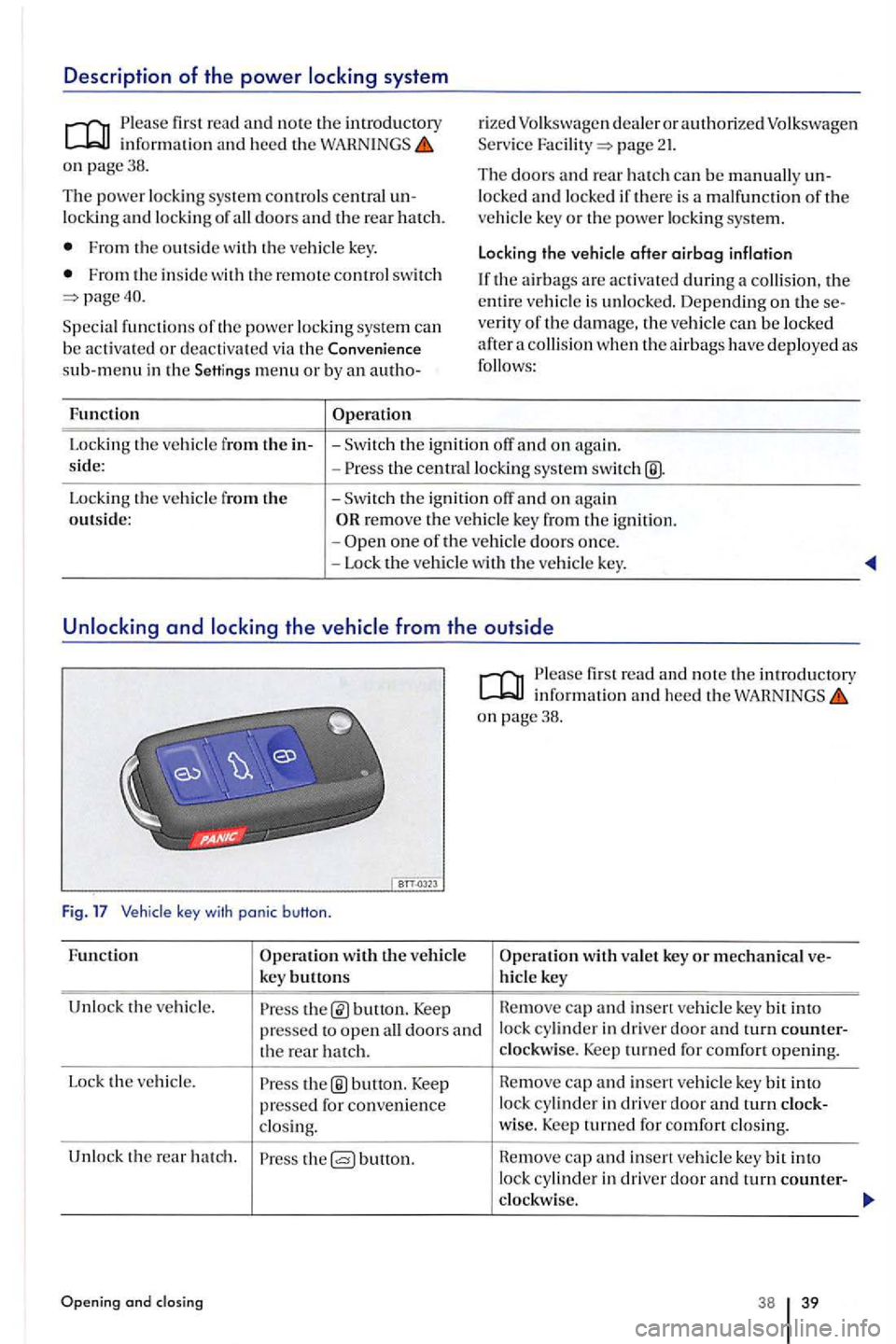
Description of the power system
firs t rea d and no te th e in troduc tory in for mation and heed the on page38.
T he pow er lockin g syst em co ntrols central un
locki ng and lock in g of all doors and the rea r hatc h .
Fro m tl1e outsid e wit h the vehicl e key.
Fro m the in sid e w ith th e remote contro l switch
Speci al fu nct io ns of the power locking syste m can
b e ac tiva ted or dea ctiva te d via the su b-m en u i n the Sett in g s menu or by an au tho-
Fun cti
on
rize d Volkswagen dealer or author ized Volkswage n
Service page 21.
T he doors an d rear h a tc h can b e manually un
l o ck e d and locke d if there is a m alf unc tio n of th e
ve hicl e key or th e power locking sys te m .
L ocki ng the vehicle
after airbag inf la tio n
the airba gs are activated during
the centra l lockin g sys tem
Locking th e ve hicle from th e
outs ide: -Swi tc h th e ig nit ion off and o n again re m ove th e vehicl e key from the ig niti on.
the
with the ve hicl e
k ey buttons
Unlo ck th e ve hicle.
firs t read and note th e introductory infor ma tion and heed th e on page38.
bunon. Keep cap and insert ve hicle key bit into
pres
sed for co nve nien ce lock i
n driver door a nd turn clock-
clo sing. w
ise. Keep turn ed for comfo rt clos ing.
U nlo ck the re a r h atc h .
butto n. cap a nd insert ve hicle key bit int o
lock cy lin der in driver door turn cowller-
clockwise.
Ope ni ng and 38 39
Page 57 of 541
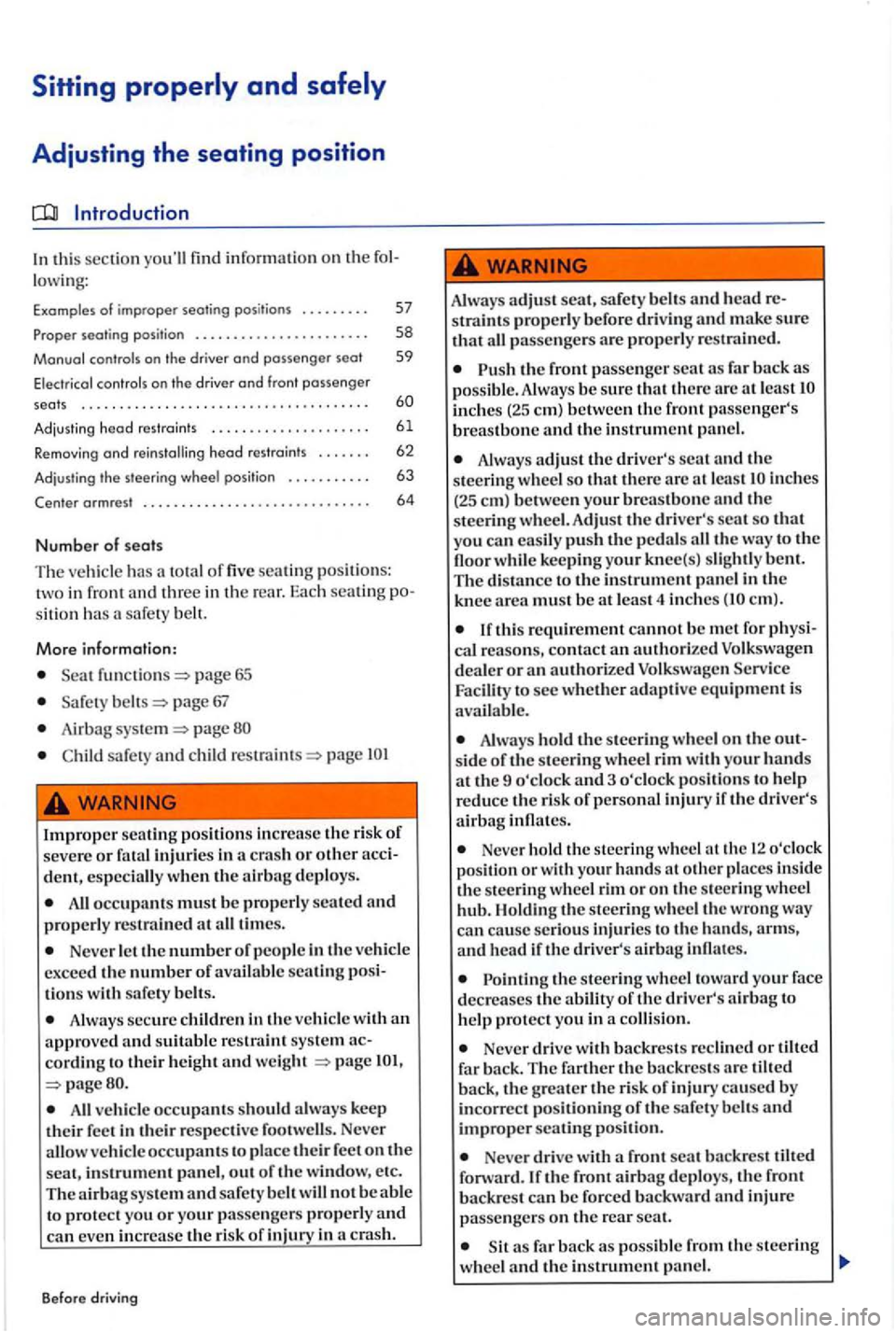
Sitting properly and safely
Adjusting the seating position
Introduction
In thi s sect io n you'll find information on th e lowing:
Examples of improper sealing positions . . . . . . . . . 57
Proper seating position . . . . . . . . . . . . . . . . . . . . . . . 58
Manual controls on the driv er and passenger
. . 62
Ad jus ting the s teeri ng wheel positio n . . . . . . . . . . . 63
Center a rmrest . . . . . . . . . . . . . . . . . . . . . . . . . . . . . 64
Number o f
Th e ve hicl e has total of five seating positio ns: in fron t and three in the re ar. Each sea tin g sition saf ety be ll.
More information:
pag e 65
page 67
Airbag page
sa fe ty and child page
Improper se atin g pos itions increase th e risk of severe or fata l injurie s in a cras h or other dent, especially w hen th e a irbag deploys.
All occupants mus t b e properly seate d and properly restra ined at all tim es.
Never lett h e number of people in the veh icle
excee d the number of availabl e seatin g tions with sa fe ty belt s.
Alw ays secure childr en in the ve hicl e with an approve d and suitable restraint system cord ing to t heir he igh t and weight
All vehi cle occupants shou ld alway s keep
th eir fee t in their r espective footwell s. Neve r
a llow veh icle occ upants to place their feet on the scat, in strume nt panel, out of th e w ind ow, etc. The and eve n in crease the risk of inju ry in a cras h.
B efore driving
Always adjust scat, sa fcry belts and head straints properly befo re drivin g and m ake sure that passe nge rs are prope rl y restrai ne d.
the front passenger sc at as
inch es (25 e m) between th e front passenge r's breastbone and the instrument panel.
Alway s adjus t the driver's scat and th e
s teeri ng wheel so that there arc at least
em).
or an authorized Volkswagen Facilit y to sec w hether adaptive equipment is availabl e.
Alwa ys hold the steerin g wheel on the side of th e steering wheel rim with your hand s at the 9 o'clock and 3 o'clock positi ons to help reduce the risk of p ersonal inju ry if th e dri ver's
a ir bag inflates.
Neve r hold the stee ring whee l at the 12 o'clo ck
po siti on or with your hand s at o th er places insid e
the stee ring wheel rim or o n th e stee rin g w hee l hub. the steering w heel the wrong way
ca n ca use serio us in juries to the hands, arms,
and h ea d if th e driver 's airbag inflates.
t h e s teeri ng whee l toward your face
d ec reases the abiliry of the driver's airbag to
h elp prot ect yo u in a co llisio n.
Never drive with backre sts reclin ed or tilt ed
far back . T he farther th e backr ests arc tilted back, the g reater th e r is k of injury caused by
in correc t positioning of th e safet y belt s and
improper seati ng position.
Never drive with a front seat backres t tilted
forward. If the front airbag deploy s, th e front
backres t ca n b e forced backward and injure
p asse ngers on th e rear scat.
far back as possibl e from the s tee ring
whee l a n d the in strument panel.
Page 58 of 541
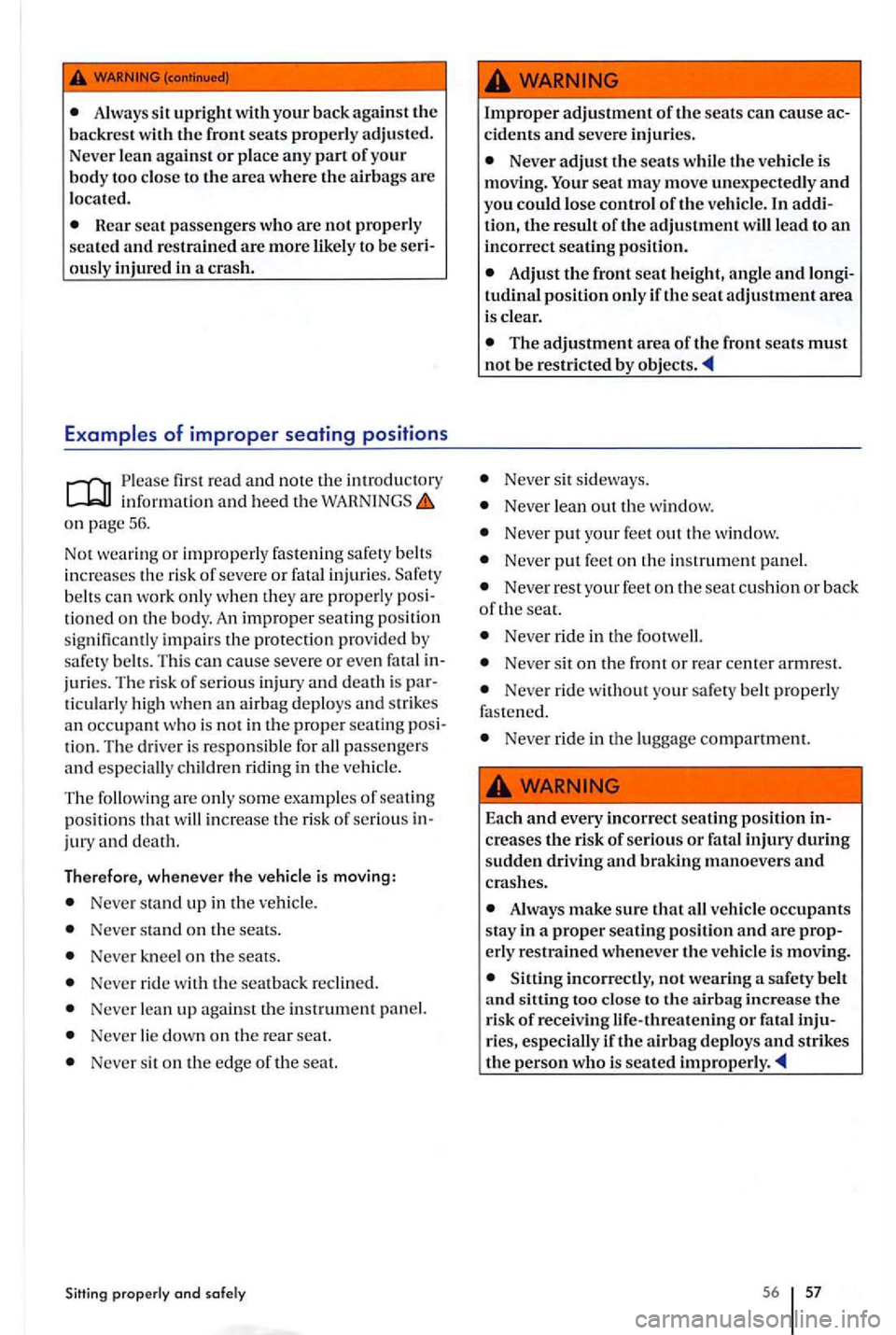
Always upright your back agains t the backrest with the front seats properly adjusted.
Never lean agains t or pla ce any part of you r
body too close to the area where the airb ags are
l oca ted.
Rear seat passengers who are not properly
seated and restrained are more lik ely to be seri
ously injured in a crash.
of improper seating positions
first r ead and not e th e introdu ctory inf ormation and hee d th e on pa ge 56.
Not w earin g or improperly fastening safety belts
i n c reases the risk of se ver e or fata l injuri es. Safe ty
b elt s can work onl y when they are prop erly po sitioned on th e bo dy. A n improp er se atin g pos ition
s ig nifi cantly impai rs the protection provided by
safety belt s. Thi s can cause se ve re or ev en fa ta l in
j uries. T he risk of se rious injur y and d eath is pa r
ti cularly hi gh wh en an airbag depl oys and strik es
an occupant who is not in the prop er seatin g pos i
ti o n. Th e driver is respons ibl e fo r pa ssen ge rs
a nd especi ally childr en riding th e vehicl e.
Th e
and dea th.
Therefore, whenever the vehicle
is moving :
Never stand up in the v ehicle .
Never stand on the seats.
Never kneel o n th e se ats.
Neve r rid e w ith the seat back re clin ed .
Neve r lea n up again st t he in strum ent pa nel.
Neve r lie dow n on the rear seat.
Neve r sit on th e edge of th e se at.
Sitting properly and safely
Improper adjustment of the seats can cause ac
cidents and severe injuries.
Never adjust the seats while the veh icle is
moving. seat may move unexpec tedly and
yo u could lose contro l of the vehicle. In addi
tion, the result of the adjustment will lead to an incorrect seating position.
Adjust the front seat height, angle and longi
tudinal position only if the seat adjustment area is clear.
The adjustment area of the front seats must not be restricted by ob jects
Nev er sit side ways.
N ever lean out the w indow.
Neve r put your feet o ut the window.
Never put feet on th e instrum ent panel.
Neve r rest your feet on the s eat cushion or b ac k of the seat.
Never rid e in the foo t well.
Neve r sit on th e front o r rea r ce nter armrest.
Neve r rid e withou t your belt prop erl y faste ned.
N ev er ride in th e lu gg age compartment.
Each
and incorrec t seating position in
creases the risk of seri o us or fatal during sudden driving and brakin g manoevers and cras hes.
Always make sure that all vehicle occupants
stay in a proper seat ing position and are prop
erly restrained whenever the vehicle is moving.
incorrec tly, not wearing a safety belt and sittin g too close to the airbag increas e the risk of receiving life-threatening or fatal inju
r ies, especially if the airbag deploys and strikes the person who is seated improperly
56 57
Page 59 of 541
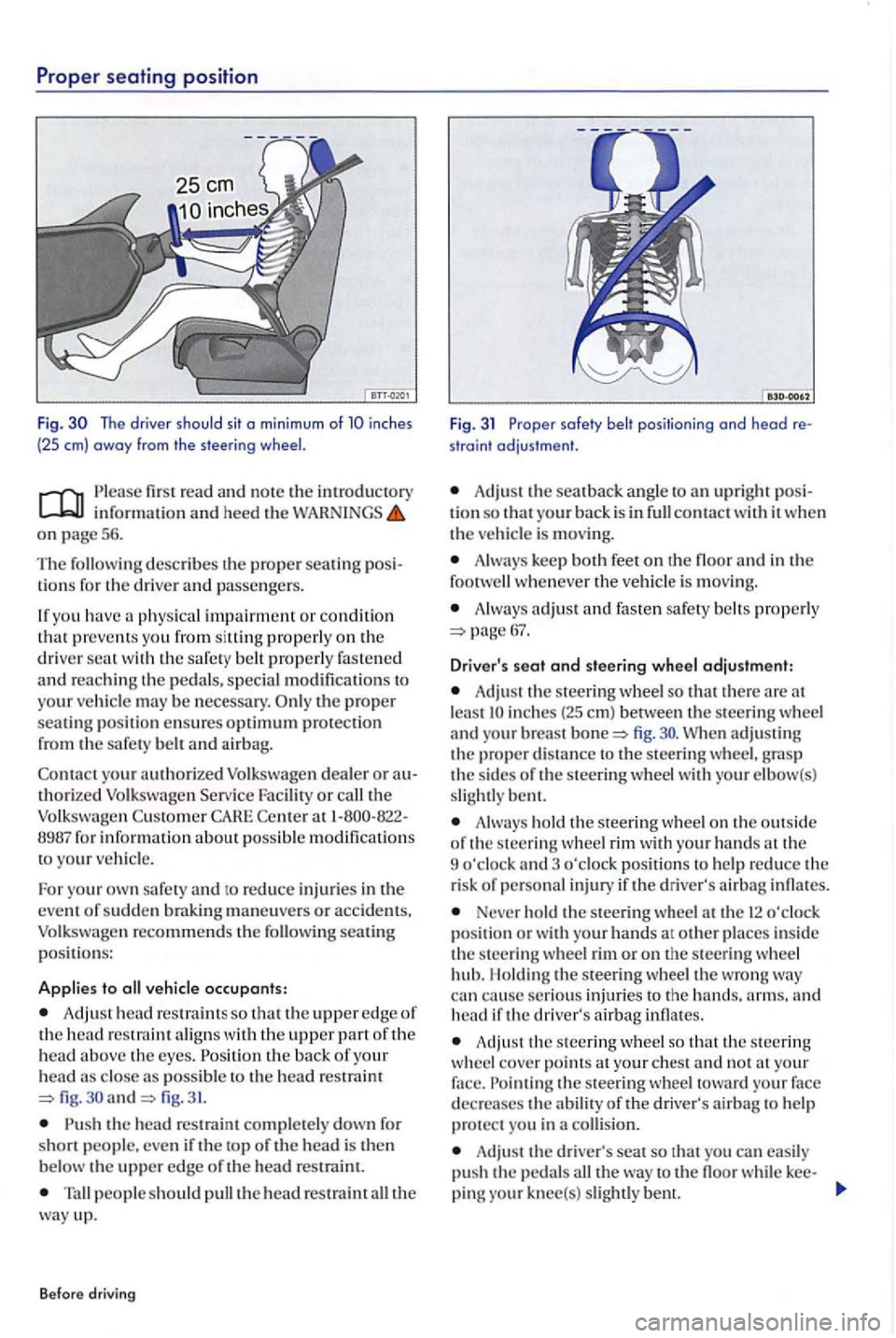
Prope r sea ting posit ion
Fig. The driver should sit o min imum of inches
(25 em) away from the steering
first read and note the introductory information an d heed the WARNINGS on page 5 6.
Th e
describes th e proper sea tin g lio ns for the driver and passengers .
If yo u hav e
physical impairment or condition that preve nts you from siltin g properly on the driver wit h the safe ty belt properly fastened and re a ching th e pedals, special modificatio ns to
your ve hicle may be necessary. p roper seating positi on ensures optimum protection from the safety belt and airbag.
Con t
act yo ur authorized Volkswagen dealer o r authorized Volk swage n Serv ice Facility or the Volkswagen Custo m er CAHE Cente r 1-800-822-
8987 fo r informati on about poss ible modification s
t o your ve hicl e.
F o r yo u r
own safety and to reduce inj urie s in the
event of sudde n brakin g maneuve rs or accid ents, Volkswagen recommends the seating p o siti ons:
Applies to vehicle occupants:
Adj ust head re straint s so that the upper edge of the head restraint aligns with the upper part of the head above th e eyes . the ba ck of your head close as poss ible fig. and fig. 31.
the head re straint completely down fo r
short people. eve n if the top of th e head is the n
b elow the uppe r edge o f the head re strai nt.
people s ho uld pull the head restraint the way up.
Before driving
Fig. 31 Proper safety belt positioning ond head re
straint adjustment.
Adjust the sea t back ang le to upri ght posi
tion so that your back is in conta ct w ith it w he n the vehicle is moving.
Alw ays keep both feet on th e floor a nd in the
foot whenever the vehicl e is mov in g.
A lway s adjust a nd fasten safety belt s pro perly
A dju st the steering wheel so that the re are lea st fig .
Always ho ld th e s teering wheel o n the out sid e
o f th e s teerin g wheel rim with your hands the
9 o'cloc k and 3 o'cloc k pos ition s to help re duce the
r is k of personal injury if the driver' s airb ag infl ates.
Never ho ld the steering wheel a t th e 12 o'clock position or w ith your hands at ot her places in side the steerin g wheel rim or o n the steerin g whee l
hub. l lo ldin g the steerin g w hee l the wro ng can cause se rious injurie s to the arms. and head if the driver's airbag infl ates.
Adju st the s teerin g wheel so that the s teerin g
w heel cove r points the ste erin g wh ee l toward your face
d ecrea ses the abilit y of the driver's airba g to help protect you in a collision.
Adju st the driver's seat so that you can easily
pu sh the pedal s the way to th e floo r while kee-
pin g knee(s) slightl y bent.
Page 71 of 541
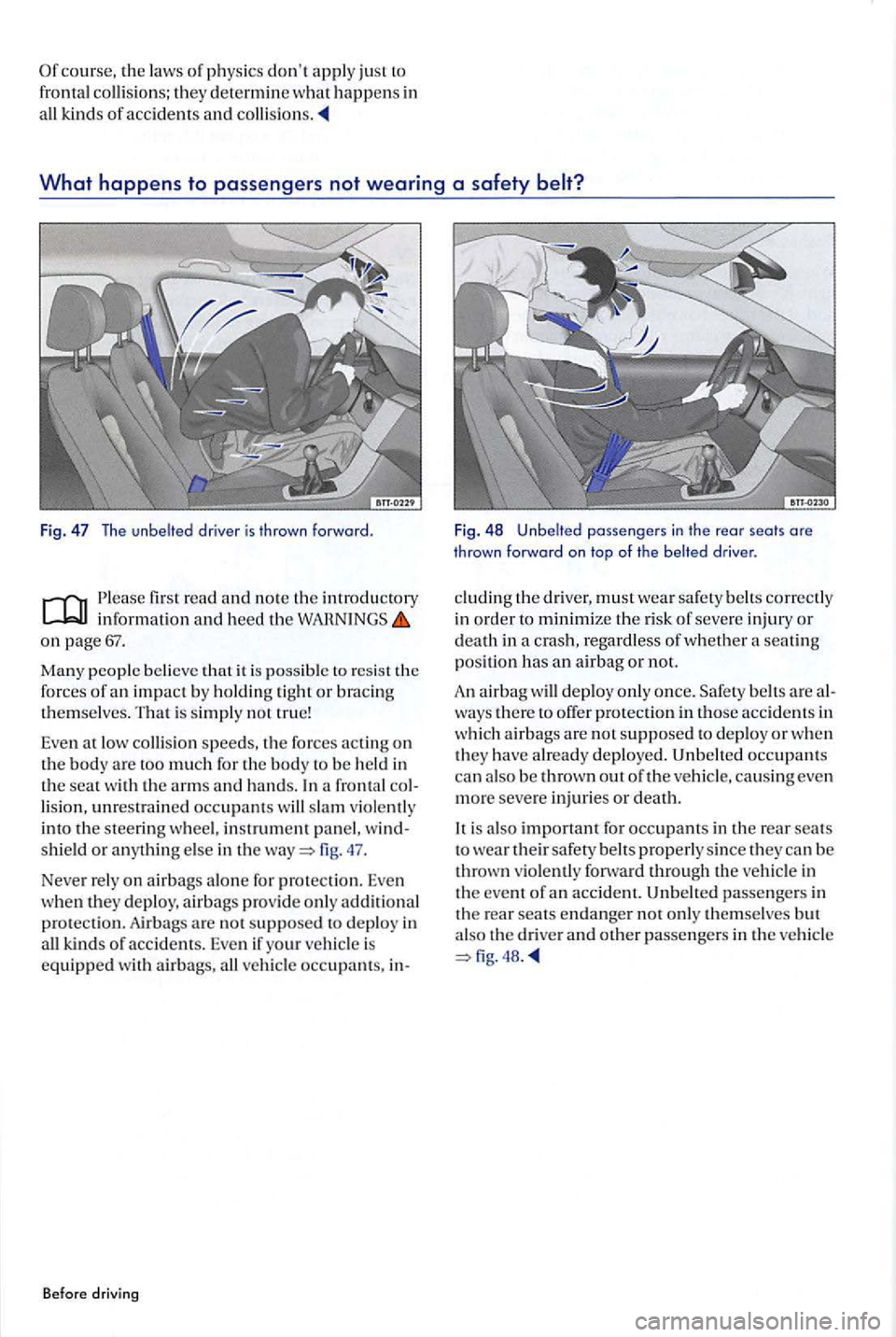
first read and note th e introducto ry information a nd heed on page 67.
Ma ny peopl e believe th at it is possib le to resis t the
forc es of an impact b y holding tight or bracin g themselves. That i s s impl y not true!
Eve n at low collis ion speeds, th e forces acting on th e body are too much for the body to be held in the seat with the arms and hands. a front al collis ion, unrestra in ed occup ants w ill slam v iolentl y
into the s teerin g wheel, instrument pane l, w indshield or anything e lse in the fig . 47.
Neve r rel y on airb ags alone fo r protection. Even
w he n they deploy, airbags pro vide o nl y additional
pro tectio n . Airbag s are no t supposed to deploy in
all kind s of accidents. Even if your ve hicl e is equippe d w ith airbags . all ve hicl e occupants, in -
Before driving F
ig. 48 U
nbelted passengers in the rear seats ore thrown forward on top of th e belted drive r .
eluding the driver, must wear sa fety belts correctly
in order to minimize th e risk of se vere injury o r
d eath in a c rash, regardless of whether
is als o impo rt ant for occupants in the rear seats
t o wea r th eir safety belts properly since they can be thrown vio lently fon vard through th e ve hicl e in
th e event of an accid ent. Unbelted passen ge rs in the rear seats endang er not onl y them se lves but al so th e drive r and other passengers in the vehicl e
Page 72 of 541
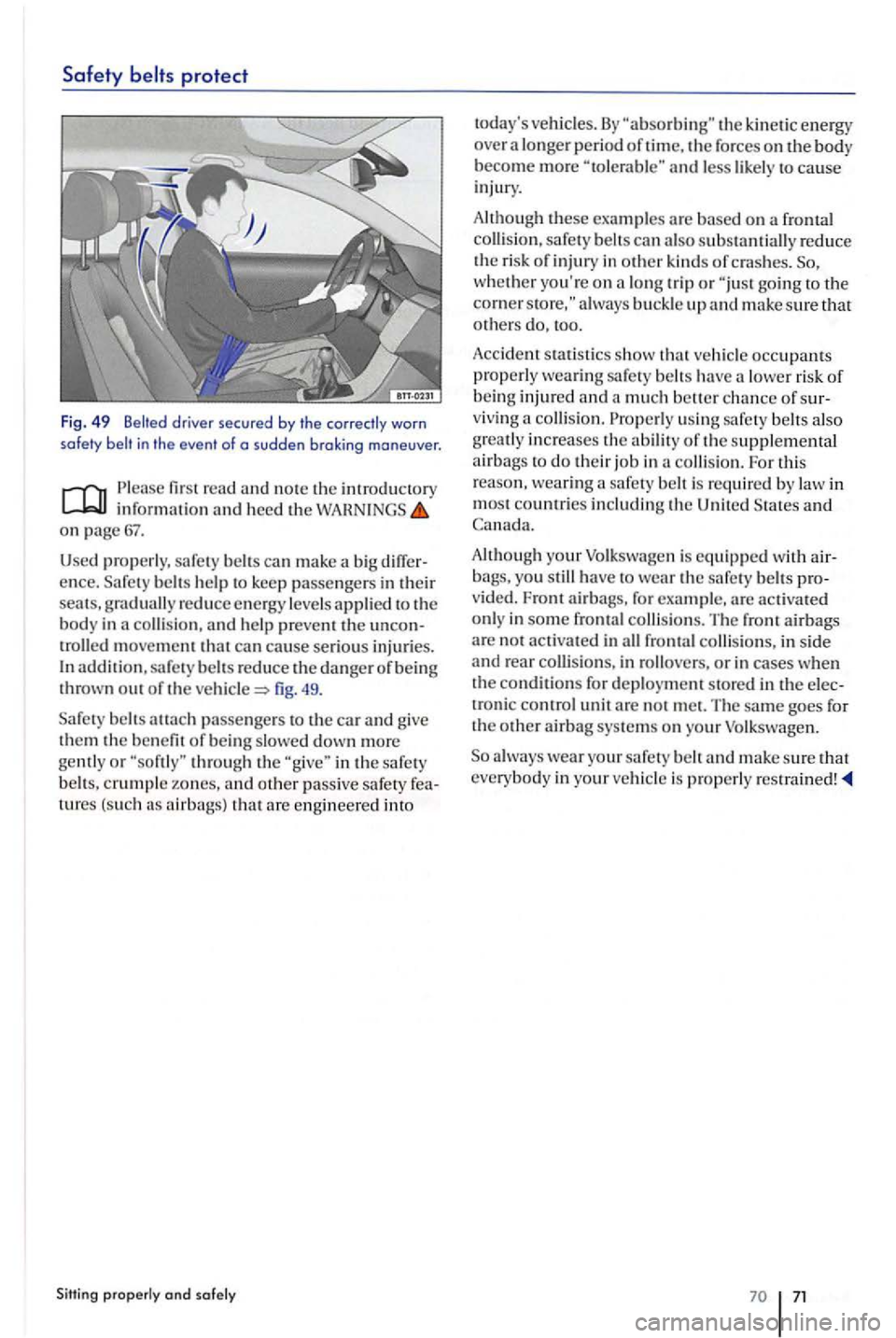
Safety
firs t r ead and no te th e information heed th e on
ence. b elts help to k eep passengers i n th eir seats, graduall y reduce e nergy leve ls appli ed t o th e
b o d y in collision, and help preve nt the can cause seriou s injuries.
I n additi on, safety belts reduce th e danger of b e in g
thro wn out or th e fig. 49.
belts pa ssengers to th e
throug h the in the safety
b elt s. c rumple z ones, lUres (su ch as airbags) that
Sitting
th e kineti c energy
ove r lo nge r perio d of time, th e for ces on th e body
b eco me m ore less lik ely to cause
injury.
A lthou gh these exa mples based on a frontal
c olli sio n, s afet y belt s ca n al so su bsta ntiall y reduce
th e ris k or injury in othe r kind s of cra shes. w heth er you're on lo ng trip or going th e corner always buc kle up
v e hicl e properly wea rin g sa fe ty belt s have low er ris k of b ein g injure d and a much be chance or collis ion. u sing safety belts a lso
gr eatl y in cre ases th e ability or the suppl em ental
airbag s to d o their jo b in collis ion. For this
r e a son, wearing a safety is re q uir ed by in
m os t coumries includin g th e Unit ed and
th e belts vid ed. a irba gs, fo r examp le , ac tivated only in some collisio n s. T he fro nt airbag s are not activa te d in fro ntal collis io ns, in side rear c olli sions, in rollove rs, or in ca se s wh en
th e c onditi ons fo r d eployment sto re d in the
always wea r your safe ty belt and make sure th at
every bo dy in your vehicle is pro perly res train ed!
71
Page 79 of 541
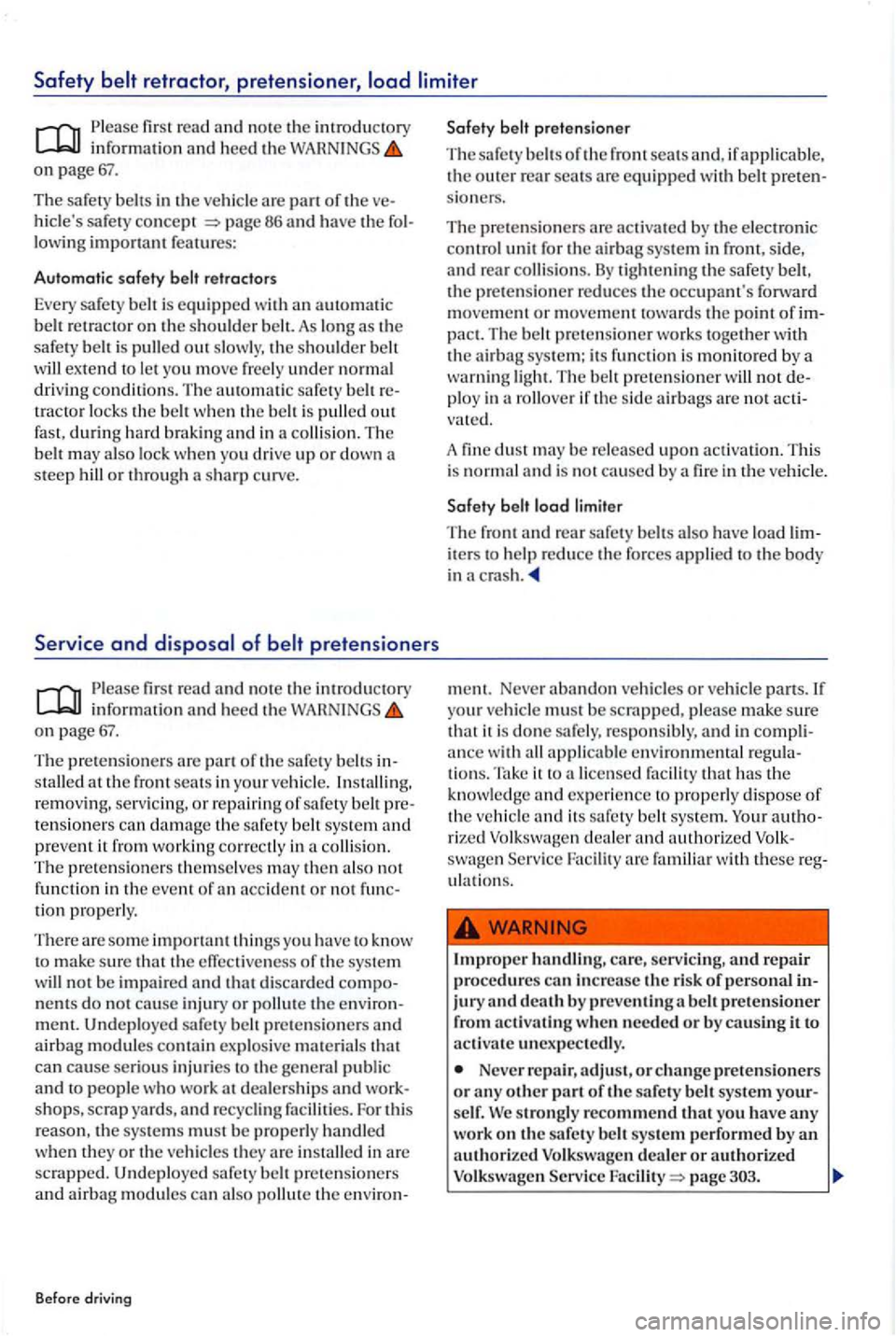
information an d h eed the on page
The safety belts in the ve hicl e are part of th e 86 and have the lowin g important features:
Automatic safety
th e safe ty belt is pull ed out slowly , the s h o ulder b elt will extend to l et yo u m ove freely under normal
driv in g condition s. The auto m atic safe ty belt tra cto r locks th e belt when the belt is pull ed ou t fast, d uring hard brakin g and in collision. T he
b elt may also lock when you dri ve up or down steep hill o r th rou gh a sharp cu rve.
informatio n and heed the on page
The prete nsione rs are part o f th e safe ty belt s stalled at th e fro n t in your ve hicle . I nstallin g.
r e mov in g, serv ic ing, or rep airin g of sa fe ty belt ten sio ne rs c an damag e th e s afety belt sys te m
tion properly.
Th ere are some import ant things yo u have to kn ow
to m ake sure that th e effective ness o f th e system w ill not be impair ed and that discar ded nents do n ot ca use inj ury or pollut e the men t. Undeployed safet y belt pre te nsio n ers and air b ag mod ules co ntain explos ive mate ria ls can cause seri o us injuries to the ge neral public
and t o people
in are sc rapp ed. Und ep lo ye d safet y belt pre tensio ne rs
a n d airba g m odules can also pollut e th e en vir on -
B efore driving
s ion ers.
Th e pr eten sio ne rs
are activated by the e le ctronic
c ontrol unit for the airbag system in front, s id e, and rea r collisions. tight ening the s afet y belt , the prete nsio ner reduces th e occupan t's fonvard
m ove ment or movement towards th e point of pact. T he belt pr ete nsioner wo rks toge ther with
th e airbag syste m ; its fun ction is monito red by a
wa rning ligh t. Th e belt prete n sione r will not
va te d .
A
dus t b e re leased upon a ct iva tion. This
i s no rmal and is no t caused by a in th e vehicle .
load l imiter
The front and rear safe ty belt s also have load iters to help reduce the fo rces applie d to the b o d y
in
m ent. Neve r abandon vehicles or vehicl e pa rt s. If
your veh icle mu st be scrapp ed, please make sure
that it i s done safe ly , re sp o nsibly, and in
swage n Fac ility familiar with these
'
Impro per handli ng, care, servici ng, and re pa ir
p rocedures can increase th e risk of p erson al ju ry and death by prev ent in g a bel t p re te nsioner from act iv ating w he n n eeded or by ca usi ng it to
a c ti vate unex pec tedly.
Neve r repair, adjust, or c hange pretensioners or any o ther part of th e s afety belt syste m strongly recom mend that you have any work on th e safety belt sy ste m perform ed by a n
a uth o riz ed
page
Page 81 of 541
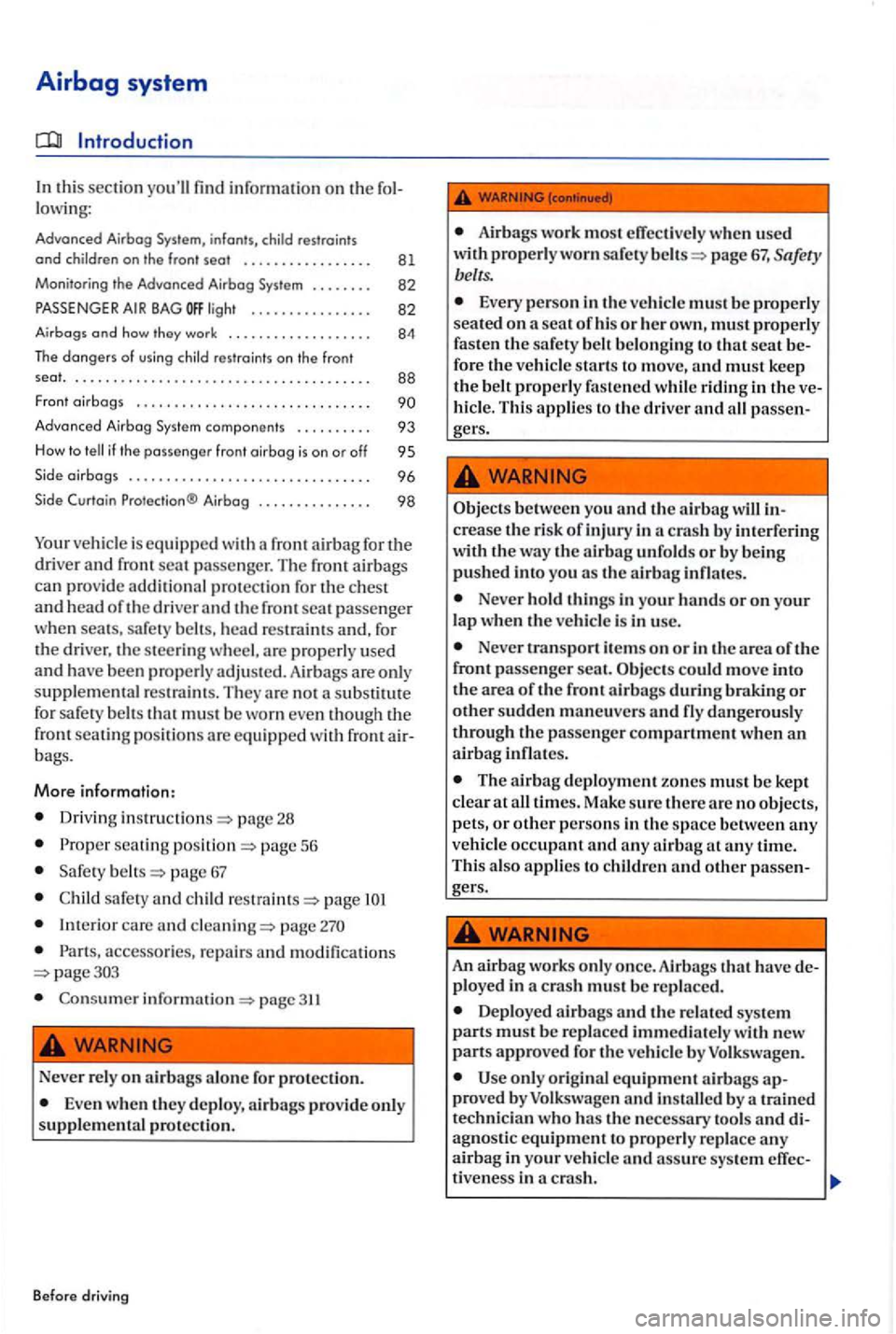
Airbag system
find information on th e fol
low ing :
Advanced Airbog
. 82
. . . . . .
Advanced Airbog Sys tem compon e nt s . . . . . . . . . . 93
H ow to if the passenger fron t oirbog is on or off 9 5
. . . . . . 98
Your vehicle is e quipped a front air bag for the
d ri ve r an d fro nt pa sse nger. The front airbag s can pro vide additional p ro tec tion fo r th e ch est and h ead of th e driver and the fro nt sea t p assenge r seats, sa fe ty belts, h ead re stra int s and, for
the driver, th e s teerin g whee l, are prop erly use d and have bee n properly adjusted. Airb ags are on ly
s u pplemental restraints. Th ey are not a su bstitut e for sa fe ty belt s th at must be wo rn eve n though front seatin g pos itions are equipp ed wit h front air
bag s.
More information:
Driv ing instru ction s=> page
seating position=> pag e 56
Safe ty belts=> page 67
sa fe ty and child pa ge
care and pag e
accessories, re pa ir s and modifica tion s pag e303
informati on=> page 311
Never rely on a irbags alone for protect io n.
Eve n when th ey deploy, airbags provide only
s uppl em ental protec tion.
Be fore driving
Airbag s work most effec tive ly w hen used
with properl y worn safe ty belt s=> page 67,
Every perso n in the ve hicl e must b e prop erl y seated on a seat of hi s or he r own, must properl y faste n th e safet y belt belongi ng to th at seat b e
for e the vehicle sta rt s to move, and must ke ep the belt properly faste n ed whil e riding in the ve
hicle. Th is a pplie s to the driv er and all
Obj ects between you an d the airbag will crease the risk of injury in a crash by interfe rin g
witl1the way the airbag unfolds or by being push ed into you as the a irbag inflates.
Never h old th ings in your hand s or on your lap when the vehicl e is in use.
Never items on or in th e area of th e
front passe nger seat. Ob jects could move into
th e a rea of the front airbag s during braking or other sudden maneu ve rs and fly dan gero usly
through the passe nge r compartment when an airbag infl ates.
The airbag deploym ent zones must be kept
clear at all tim es. Make sure there are no objects ,
pets, or ot her persons in the space be tween any ve hicl e occupant and any airb ag at an y time. Thi s also applie s to c hildr en and o ther pa sse n
gers .
WARNING-
An airb ag works o nl y once. Airbag s th a t h ave de
plo yed in a cras h must be re placed.
Deployed airbag s and the re lated sys tem
p art s must b e repla ced immediately with new parts approved for the ve hicl e by Volkswagen.
Use o nly orig inal equipment airb ags ap
prov ed by Volkswag en and by a trained
techni cian who has the necessary too ls and di
agnostic eq uipmen t to properl y replace an y airbag in your ve hi cle and assure sys te m effec-
ti veness in a c rash.